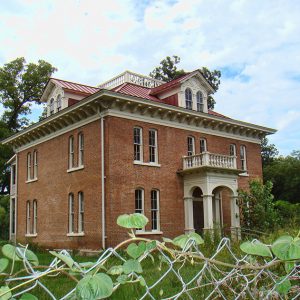calsfoundation@cals.org
Palmer's Folly
aka: John C. Palmer House
Palmer’s Folly was an elaborate Italianate-style residence built near Blackton (Monroe County) in the Arkansas Delta by prominent Helena (Phillips County) lawyer John C. Palmer in the early 1870s. Listed on the National Register of Historic Places on May 4, 1976, the building burned to the ground in May 2013 while it was being restored.
John Coleman Palmer was born in Lexington, Kentucky, on May 12, 1823. He studied law and graduated from Transylvania University in Lexington in 1845. In September of that year, he moved to Helena and established a law firm. A year later, he served as a sergeant in the Phillips County company of the First Arkansas Mounted Rifles during the Mexican War, fighting at the Battle of Buena Vista before returning home. He married Margaret E. Shell in 1852—the couple would have seven children—and received a land grant for 350 acres in Monroe County, conveniently near the route of the planned Arkansas Midland Railroad, of which he served as a charter member and secretary of the board.
Thomas Carmichael Hindman became Palmer’s partner after moving to Helena in 1856, and their law office was advantageously located across the street from the county courthouse. A Catholic Whig, Palmer became an ardent Democrat after the Know-Nothing Party supplanted the Whigs. He joined the Confederate army in August 1862, with Hindman installing him on his staff as his chief commissary officer with the rank of major. After the war, Palmer and Hindman reestablished their law practice in Helena when the latter returned from a brief exile in Mexico. They worked together until Hindman’s 1868 assassination.
Palmer began building an elaborate home on his Monroe County property in 1870, and he and his family lived in a log house on the grounds during the three years of its construction. The result was a two-story brick building designed in the Italianate style, with scrolled brackets at the cornice, gable-roofed dormers, and a two-story porch along the central bay, which was replaced with a four-columned portico around 1906.
Palmer improved his 350 acres and paid particular attention to landscaping around the two-story mansion in remote Monroe County. According to the National Register nomination, “The yard was at one time a labyrinth of flowers and bushes of all shapes and sizes. The lavishness of the folliage [sic] and Palmer’s financial devotion to its upkeep inspired the local usage of ‘Palmer’s Folly’ in referring to the Palmer House.”
Palmer practiced law for fifty-six years and died on May 1, 1900. After his death, his son James owned it, and grandson John C. Palmer took possession after James Palmer died. By the early 1990s, the building stood empty in a field near the Louisiana Purchase Historic State Park on U.S. Highway 49, an oddity for the fascination of passersby. In 2006, preservationist Richard C. Butler III and his business partner Jeremy Carroll acquired it and began a painstaking restoration. They had nearly completed the exterior and were about to begin interior work when a fire broke out at an electrical breaker box in the attic in late May 2013. The building was consumed. An editorial obituary for Palmer’s Folly in the Arkansas Democrat-Gazette stated: “Survivors include shocked mourners throughout the state, especially those who understand that historic preservation is not just an ancillary activity, a hobby for antiquarians, but an elemental part of life in the present.” The building was removed from the National Register on January 22, 2014.
For additional information:
“The Death of a Dowager—An Obituary for a Solitary Lady.” Arkansas Democrat-Gazette, June 4, 2013, p. 6B.
Frazier, William F., and Mark K. Christ, eds. Ready, Booted, and Spurred: Arkansas in the U.S.-Mexican War. Little Rock: Butler Center Books, 2009.
Neal, Diane, and Thomas W. Kremm, Lion of the South: General Thomas C. Hindman. Macon, GA: Mercer University Press, 1993.
“Palmer House.” National Register of Historic Places registration form. On file at Arkansas Historic Preservation Program, Little Rock, Arkansas.
Worthen, John. “1870s Plantation Home Mourned.” Arkansas Democrat-Gazette, June 2, 2013, pp. 1, 3.
Mark K. Christ
Central Arkansas Library System


 Palmer House
Palmer House 



Comments
No comments on this entry yet.